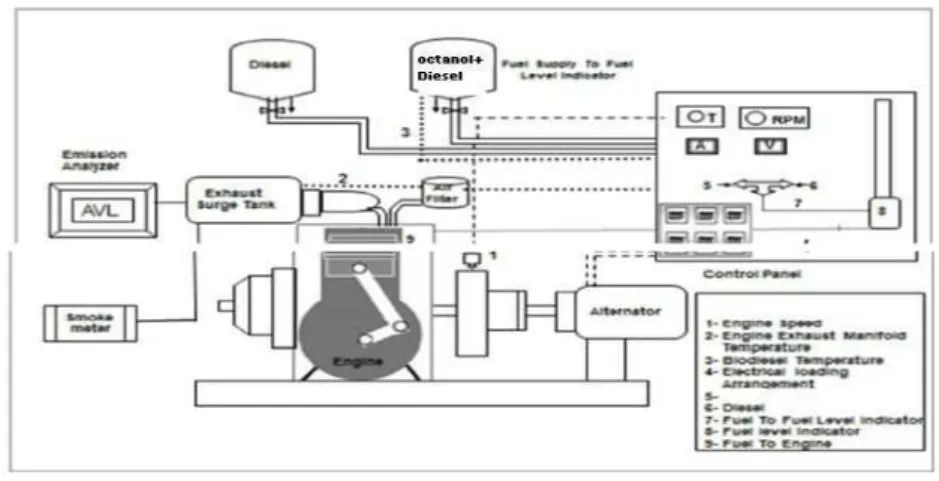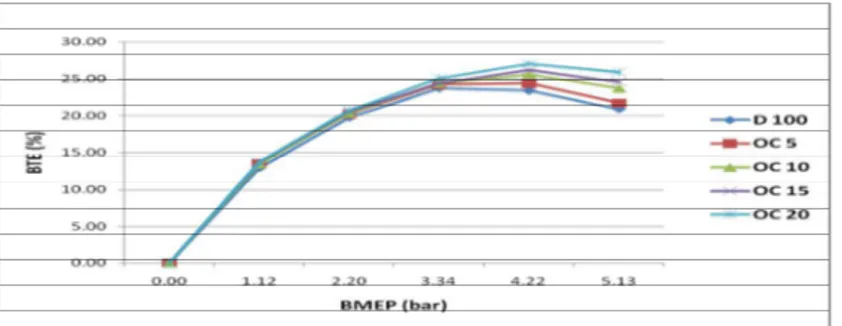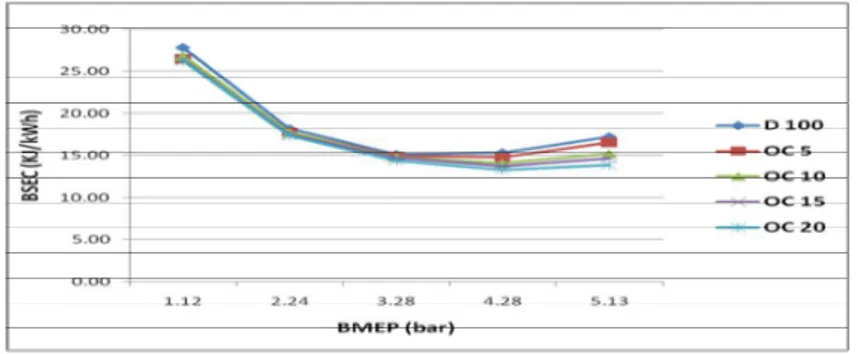Performance characteristics of a single
cylinder diesel engine fuelled with
1-octanol diesel blends
Rashi Koul
Department of Mechanical Engineering Bio Diesel Laboratory
Delhi Technological University;Bawana;Delhi, India
Abstract- Various research related to the use of alcohols so far as alternative fuels for internal combustion engines has been focused on the employment of short chain alcohols, mainly methanol and ethanol, blended with fossil fuels. Despite of their adequate combustion properties, long chain alcohols have been barely investigated.
There is a growing interest on using alcohols to substitute diesel fuel, as the use of oxygenated fuels involves oxygen enrichment leading to enhancement of premixed combustion phase and improved emissions.
The main objective of this paper is to study higher chain alcohol like Octanol which may provide a real insight in to the potential usage of these largely unexplored alternative fuels in diesel engines. The present study deals with the utilisation of 1-Octanol and diesel blends on a single cylinder diesel engine to characterise performance.
The 1-octanol was volume wise substituted by 5%, 10%, 15% and 20% in the mineral diesel and named as OC5, OC10, OC15 and OC20 respectively. Neat diesel was named as D100. The experimental engine trial results showed an increase in brake thermal efficiency (BTE) and reduction in brake specific fuel consumption (BSFC) and increased exhaust temperature.
Keywords: Engine performance, 1-octanol diesel blends.
I. INTRODUCTION
Energy is one of the most important building blocks in human development, and, as such, acts as a key factor in determining the economic development of all countries. Reduction in engine emissions becomes a major task in engine development due to the increasing concern of environmental protection and more stringent emission norms. In addition to this, efforts are needed to reduce dependence on the petroleum fuels as it is obtained from limited reserves [1]. Diesel engine has a higher thermal efficiency and produces higher power that can save more fuel compared to gasoline engine [2]. Hence diesel engines are usually used for heavy duty vehicles. Several experimental studies have been carried out around the world to evaluate the engine performance of methanol diesel blends and ethanol diesel blends [4, 6-14].
This experiment was conducted by taking higher carbon chain alcohol like 1-octanol, as its various property values were almost same to that of the diesel. 1-octanol was easily miscible in diesel, hence overcoming the disadvantage of immiscibility of methanol and ethanol with diesel fuel [4,5]. However, in case of methanol, ethanol diesel blends problem to some extent can be solved by adding octyl nitrate [5] or methyl ester [7,8].
1-octanol has number of advantages. It is produced industrially by the oligomerisation of ethylene using triethylaluminium followed by oxidation of the alkylaluminium products.
An idealised synthesis is shown Al(C2H5)3+ 9C2H4àAl(C8H17)3
Al(C8H17)3+3O + 3H2Oà3C8H17OH + Al(OH)3
The experiment was carried on a Kirloskar make, single cylinder, air cooled, direct injection, DAF8 model diesel engine. Break thermal efficiency, break specific fuel consumption and exhaust temperature were found out for different proportions like D100, OC5, OC10, OC15 and OC20.
II. EXPERIMENTAL SET UP & PROCEDURE
Table 1. Specifications of the Diesel Engine
Make Kirloskar
Model DAF 8
Rated Brake Power (bhp/kW) 8 / 5.9
Rated Speed (rpm) 1500
Number of Cylinder One
Bore X Stroke (mm) 95 x 110
Compression Ratio 17.5:1
Cooling System Air Cooled (Radial Cooled)
Lubrication System Forced Feed
Cubic Capacity 0.78 Lit
Inlet Valve Open (Degree) 4.5 BTDC
Inlet Valve Closed (Degree) 35.5 ABDC
Exhaust Valve Open (Degree) 35.5 BBDC
Exhaust Valve Closed (Degree) 4.5 ATDC
Fuel Injection Timing (Degree) 26 BTDC
The main features of an engine are presented in the Table 1.
Table 2. Fuel properties
Property Mineral Diesel 1-Octanol Diesel blend
Density(kg/m
3
) 810 823.56
Kinematic Viscosity at 40°C (cSt) 2.5 3.387
Cold Filter Plugging Point (CFPP) (°C) -13 -10
Calorific value (kJ/kg) 42,200 37634.68
The Table 2 compares the properties of mineral diesel and 1-octanol diesel blend.
Figure 1. Schematic Diagram of the Experimental Set Up
The Figure 1. gives the complete layout of the experimental setup.
hand started using decompression lever and is provided with centrifugal speed governor. The cylinder is made of cast iron and fitted with a hardened high-phosphorus cast iron liner. The lubrication system used in this engine is of wet sump type, and oil is delivered to the crankshaft and the big end by means of a pump mounted on the front cover of the engine and driven from the crankshaft. The inlet and exhaust valves are operated by an overhead camshaft driven from the crankshaft through two pairs of bevel gears. The fuel pump is driven from the end of camshaft.
Once the parameters like power, engine speed, fuel consumption, temperature were selected, the essential instruments required for sensing these parameters were installed at the appropriate points in the experimental set-up.
In the present set up volumetric fuel consumption was measured using a glass burette. The time taken by the engine to consume a fixed volume of 10cc was measured using a stopwatch. The volume divided by the time taken for fuel consumption gave the volumetric flow rate. After stable operating conditions were experimentally achieved, the engine was subjected to similar loading conditions. Starting from no load, observations were recorded at 20%, 40%, 60%, 80% and 100% of the rated load. Chromel-Alumel K-type thermocouples were connected to a 6 channel digital panel meter to measure temperatures of exhaust gas.
The engine was started at no load. After feed control was adjusted so that engine attains rated speed and was allowed to run (about 30 minutes) till the steady state condition was reached. With the fuel measuring unit and stop watch, the time elapsed for the consumption of 10cc of fuel was measured for OC5, OC10, OC15 and OC20 at varying load. Fuel Consumption, RPM, exhaust temperature were measured. The engine was loaded gradually keeping the speed with in the permissible range and the observations of different parameters were evaluated. Short term performance tests were carried out on the engine with diesel to generate the base line data and subsequently blend was used to evaluate its suitability as a fuel. The performance characteristics of the blend fuel were evaluated and compared with diesel fuel.
III. RESULTS AND DISCUSSIONS
3.1. Performance Characteristics
The performance characteristic of test engine on octanol diesel blends is summarized below. 3.1.1. Brake Thermal Efficiency
Figure 2. shows the variation of different octanol diesel blends in comparison to neat diesel. It is clear that the Brake Thermal Efficiency (BTE) first increase with increase in load and thereafter it decreases. It is also found that BTE is increasing with increasing volume of octanol in octanol diesel blends. The maximum BTE observed for the blends OC 5, OC 10, OC 15 and OC 20 are 24.46%, 25.59%, 26.19% and 27.02% respectively. The maximum BTE in case of neat diesel is 23.71%. The increase in BTE with addition of octanol in diesel may be due to the fact that octanol is oxygenated which results in improved combustion. Moreover, addition of octanol in diesel also reduces kinematic viscosity which makes atomization better [9]. The results are similar to the results obtained by Rakapoulus [16] and O.Dogan [17].
Figure 2. BTE v/s BMEP
3.1.2. Brake Specific Energy Consumption
As seen from the Fig. 3, the BSEC reduces with the increase in Brake Mean Effective Pressure (BMEP). BSEC of the octanol-diesel blend is lower than the baseline data for the neat diesel. This is mainly because of presence of oxygen in octanol which helps in better combustion. Due to better combustion of fuel blends, requirement for energy is reduced and hence BSEC of blends decreases in comparison to baseline data. Decrease in kinematic viscosity of blends due to presence of octanol also helps in better atomization on fuel and subsequent better consumption [9,12].
Figure 3. BSEC v/s BMEP
3.1.3.Exhaust Temperature
Figure. 4. shows the variation of exhaust temperature with brake mean effective pressure for different blends of octanol and neat diesel. The result shows that the exhaust temperature increases with the increase in brake power in all the cases. The increase in exhaust temperature with octanol addition may be due to better combustion, which leads to increased cylinder temperature and hence increased exhaust temperature [12, 20].
Figure.4. Exhaust temperature v/s BMEP
IV. CONCLUSIONS AND SCOPE FOR FUTURE WORK
4.1 Conclusion
The purpose of the present study was to evaluate the performance characteristics of a higher carbon chain alcohol diesel blend, i.e; octanol diesel blend on an unmodified diesel engine. On the strength of exhaustive engine trial, the following major conclusions have been drawn:
1. The brake thermal efficiency of the octanol diesel blends (OC 5, OC 10, 0C 15 and OC 20) were found higher than neat diesel (D100).
2. The brake specific energy consumption was found to be lower for the blends in comparison to neat diesel. 3. 1-octanol was easily miscible in diesel, hence overcoming the disadvantage of immiscibility of methanol and ethanol with diesel fuel
V. FUTURE WORK
On the basis of present work done, the following directions are indicated for further investigations and developments.
In the present study, an unmodified diesel engine was used, however, it is expected that certain modifications may be required for better performance. Therefore, the engine design may be modified, specially the injection system for using blends of 1-octanol and diesel.
The short term trial of engine was carried out in the present work. There is an urgent need to carry out long term endurance test to assess the suitability of 1-octanol-diesel blends on an engine.
REFERENCES
[1] Hulwanm DB, Joshi SV. Performance, emission and combustion characteristic of a multicylinder DI diesel engine running on diesel– ethanol–biodiesel blends of high ethanol content. Applied Energy 2011;8 (12):5042–55.
[2] Huang J, Lin J, Wang Y, Qin J, Roskilly AP, Li L, Ouyang T, Yu Y. Experimental study of the performance of and emission characteristics of diesel engine using direct and indirect injection systems and different fuels. Fuel Process Tech 2011; 92: 1380-1386. [3] Can O, Celikten I, Usta N. Effects of ethanol addition on performance and emissions of a turbocharged indirect injection diesel engine
running at different injection pressures. Energy Convers Manage 2004;45:2429-2440.
[4] Shi X, Pang X, Mu Y, He H, Shuai S, Wang J, Chen H, Li R. Emission Reduction Potential of Using Ethanol-Biodiesel-Diesel Fuel Blend on a Heavy-duty Diesel Engine. Atmospheric Environment 2006;40:2567-2574.
[5] Rakopoulos DC, Rakopoulos CD, Karakas EC, Giokoumis EG. Effects of ethanol–diesel fuel blends on the performance and exhaust emissions of heavy duty DI diesel engine. Energy Convers Manage 2008;49:3155-3162.
[6] Sayin C, Cacakci M. Effects of injection timing on the engine performance and exhaust emissions of a dual-fuel diesel engine. Energy Convers Manage 2009;50:203–213.
[7] Cetin M, Yuksel F, Kus H. Emission characteristics of a converted diesel engine using ethanol as fuel. Energy for Sustainable Development 2009;13:250–254.
[8] Surawski NC, Ristovski ZD, Brown RJ, Situ R. Gaseous and particle emissions from an ethanol fumigated compression ignition engine. Energy Conversion and Management 2012;54:145–151.
[9] Kumar MS, Kerihuel A, Bellettre A, Tazerout M. Ethanol animal fat emulsions as a diesel engine fuel – part 2: engine Test analysis. Fuel 2006;85:2646–2652.
[10] Pidol L, Lecointe B, Starck L, Jeuland N. Ethanol–biodiesel–diesel fuel blends: performances and emissions in conventional diesel and advanced low temperature combustions. Fuel 2012;93:329–338.
[11] Huang J, Wang Y, Li S, Roskilly AP, Yu H, Li H. Experimental investigation on the performance and emissions of a Diesel engine fuelled with ethanol–diesel blends. Appl Therm Eng 2009;29:2484–2490.
[12] Park HS, Youn IM, Lee CS. Influence of ethanol blends on the combustion performance and exhaust emission characteristics of a four-cylinder diesel engine at various engine loads and injection timings. Fuel 2011;90:748–755.
[13] Hulwan DB, Joshi SV. Performance, emission and combustion characteristic of a multicylinder DI diesel engine running On diesel– ethanol–biodiesel blends of high ethanol. Appl Energy 2011;88:5042–5055.
[14] D.C.Rakopoulos, C.D.Rakopoulos, E.G.Giakoumis, A.M.Dimaratos and D.C.Kyritis. Effects of butano-diesel fuel blends on the performance of a high speed DI diesel engine, Energy Conversion and Management, Vol.51, NO.10, 2010, 1989-1997.
[15] O.Dogan; the influence of n-butanol/diesel fuel blends utilisation on a small diesel engine performance and emissions fuel; Vol-90, pp 2467-2472, 2011.
[16] AC Hansen, MR Gratton, Yuan W. Diesel engine performance and NOx emissions from oxygenated biofuels and blends with diesel fuel. Trans ASABE 2006;49(3):589–95.
[17] Deepak Agarwal, Lokesh Kumar, Avinash Kumar Agarwal ,Performance evaluation of vegetable oil fuelled compression ignition engine, Renewable Energy 33 (2008) 1147–1156.


